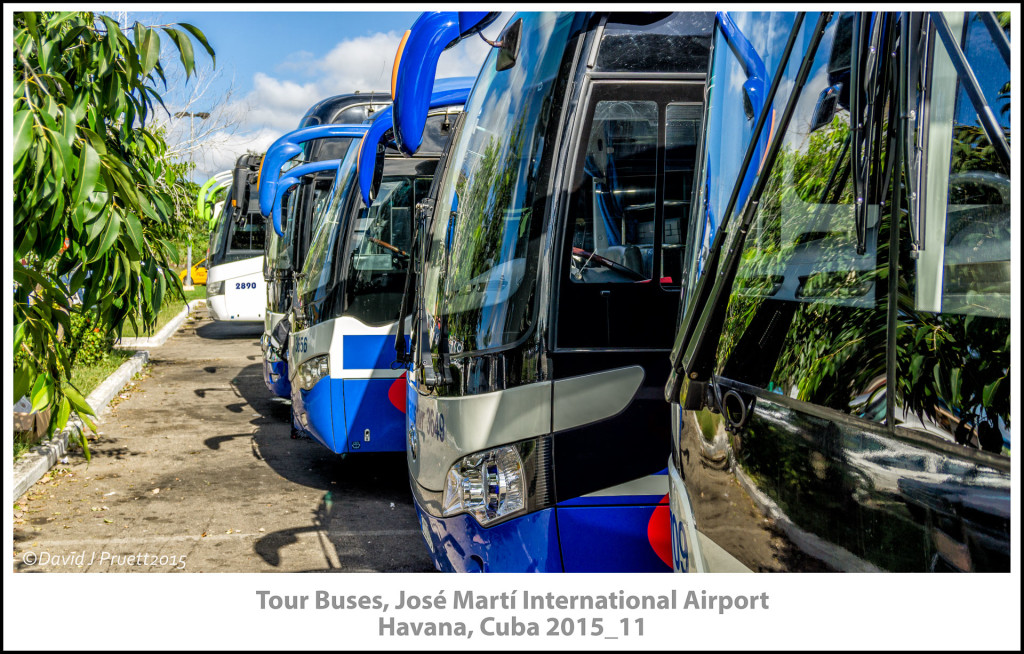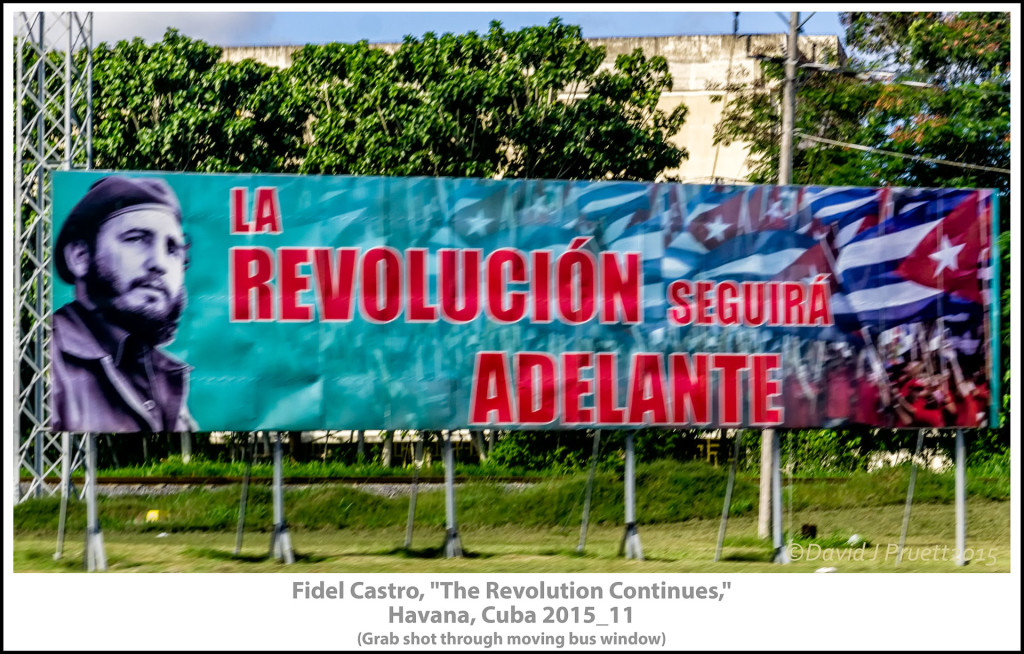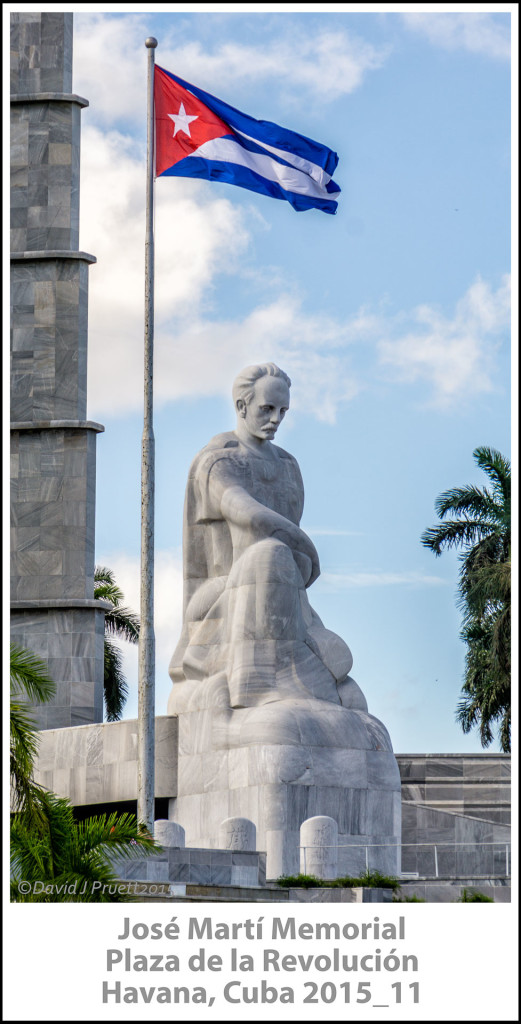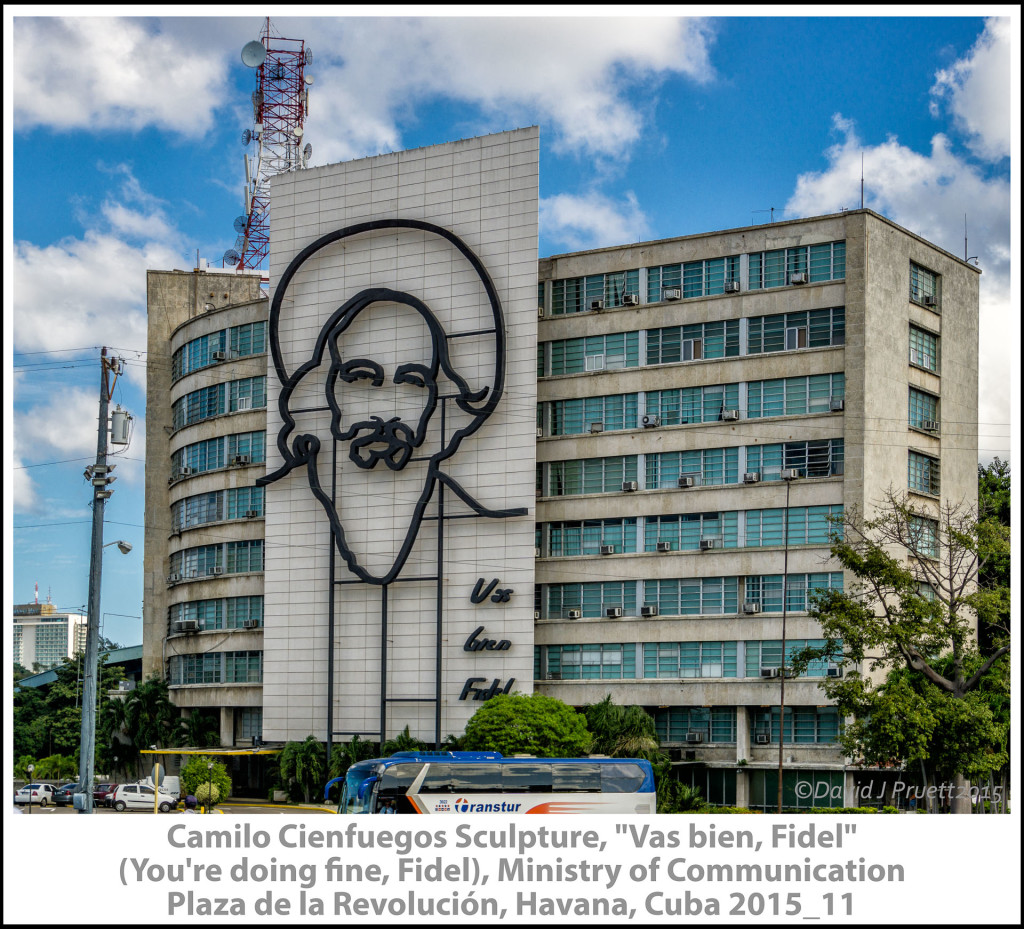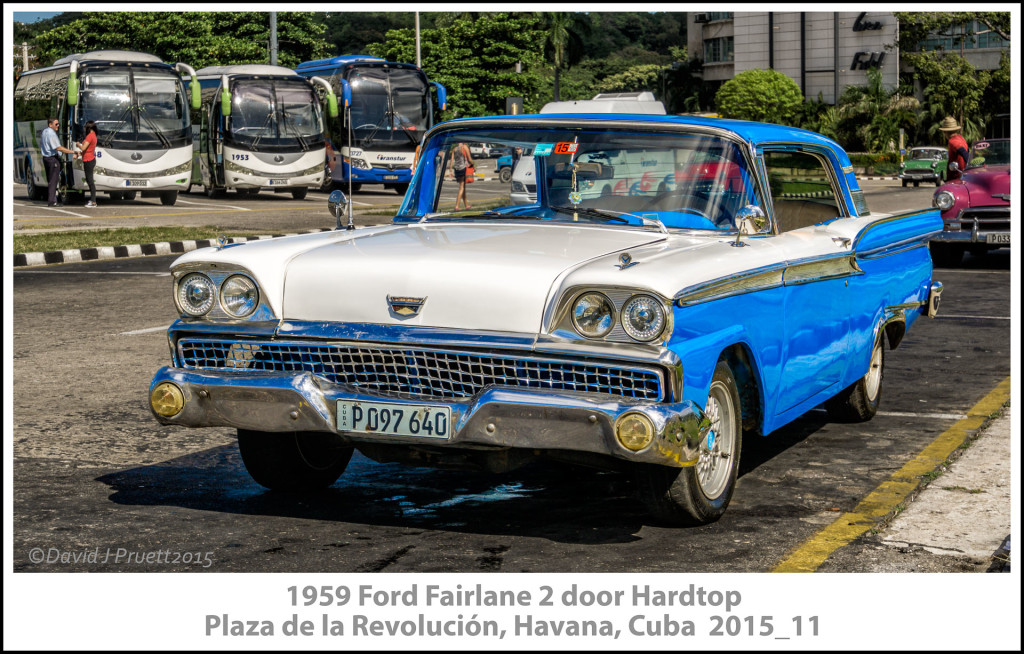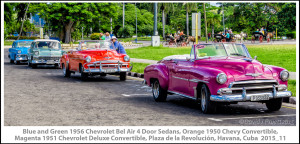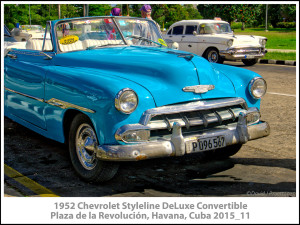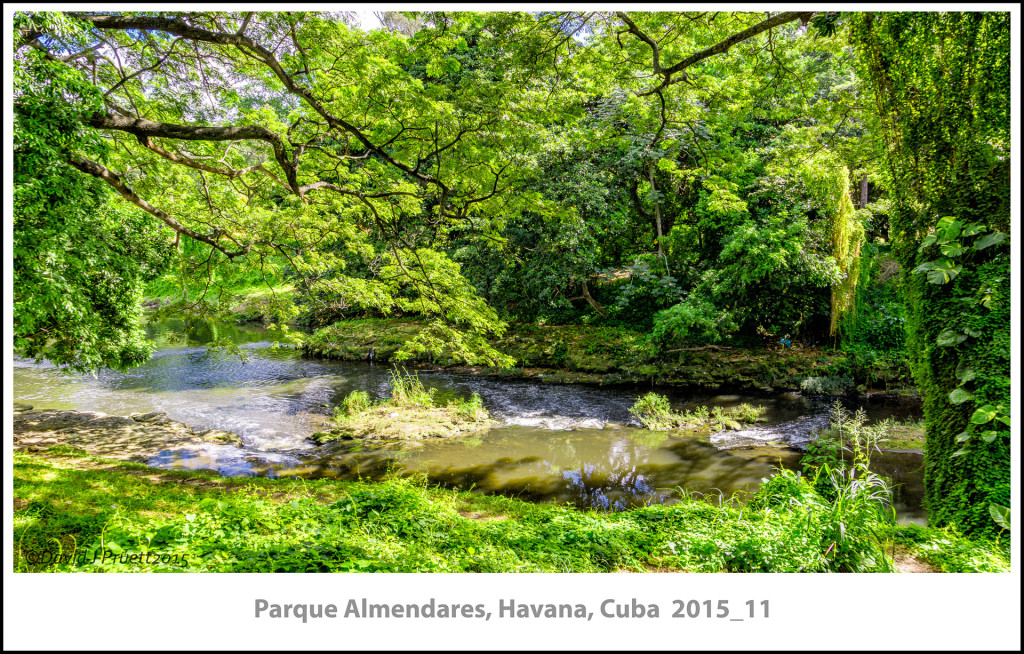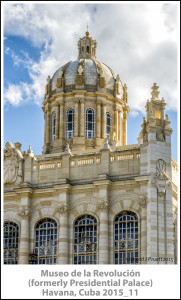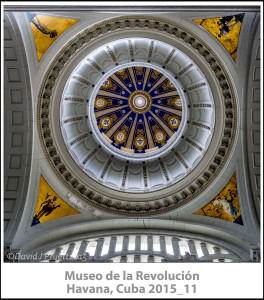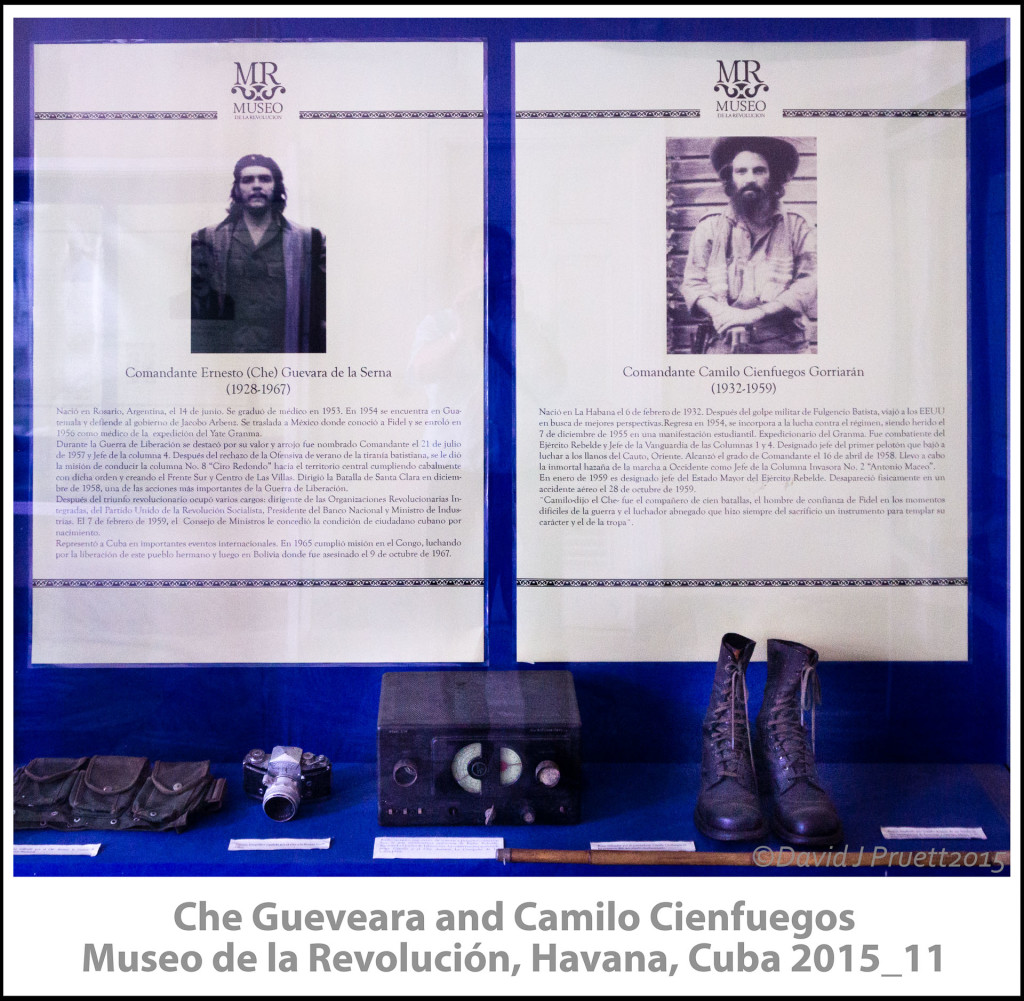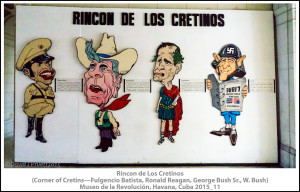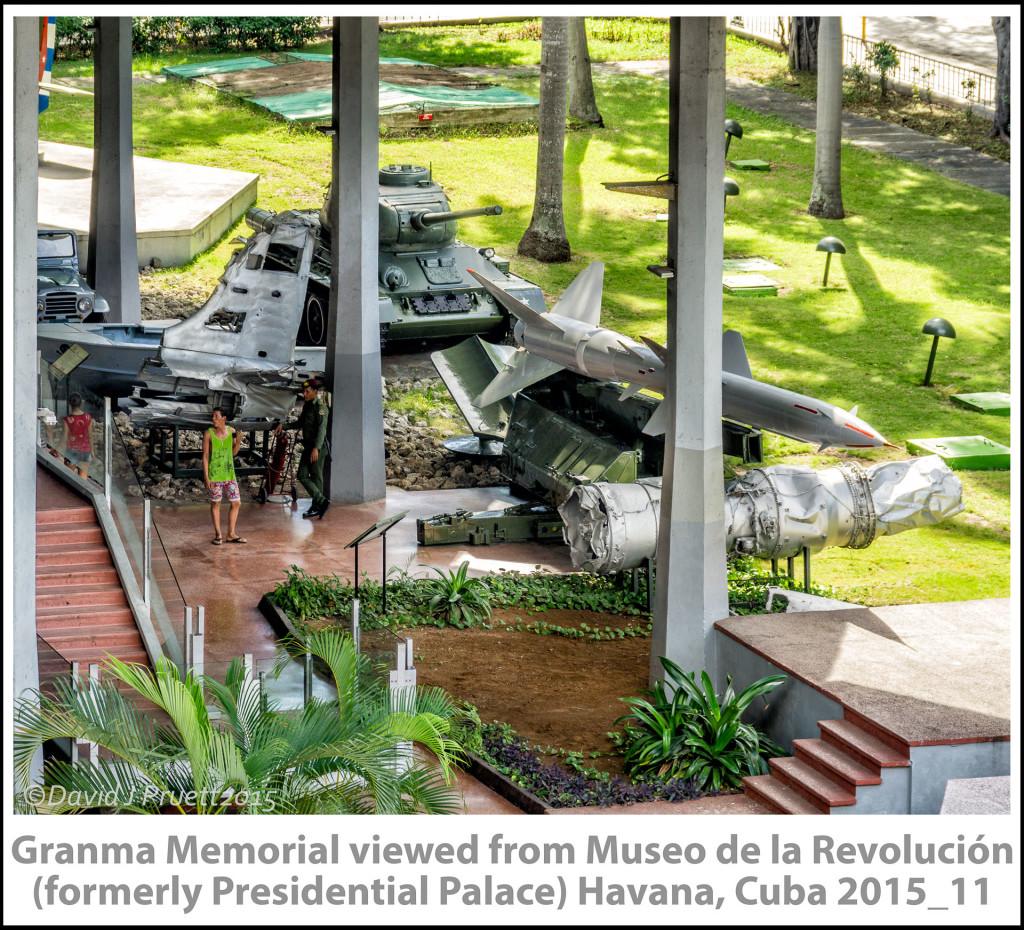Day 1: Arrival. Viva la Revolución!
If you have ever wondered whether or not you should visit Cuba, the answer is yes.
Why?
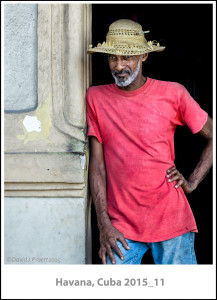 |
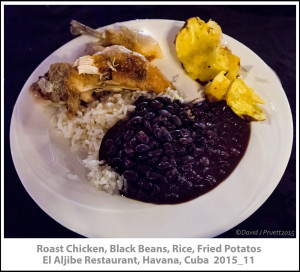 |
 |
| The People:
warm, friendly and diverse |
The Food: not a foodie paradise, but delicious |
The Architecture: once a jewel of the Caribbean, Havana has, sadly, decayed |
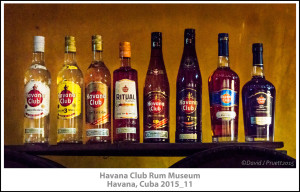 |
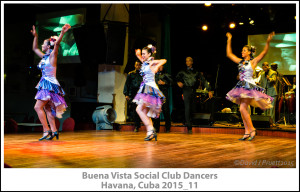 |
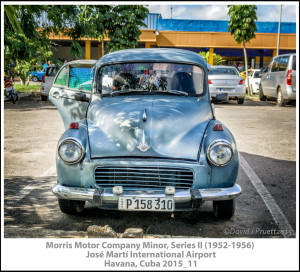 |
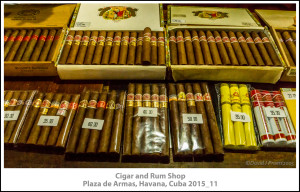 |
|
The Rum: smooth and complex |
The Music and Dance: the passion of the local bands will make you move |
The Cars: immaculate cars from the 1950s |
The Cigars: a cigar-lovers heaven |
ArrivalEven though it is easier than ever to get to Cuba, the prospect of traveling to this “forbidden” location is still exciting. US citizens are not allowed to go as simple tourists. You must be going to visit relatives or for one of a dozen or so broadly defined purposes related to academics, culture or sports. Ours was a cultural tour focused on food, drink, music and art. If you have traveled to any Caribbean island before, the Aeropuerto Internacional JoséMartíLaHabana (Havana José Martí International Airport) will look familiar. No jetways, no air conditioning, small and crowded. Nevertheless, luggage arrived quickly and we passed easily through customs and passport control. This was a pleasant surprise as visitors in the past had warned me of detailed searches of bags and lots of questions by customs officials. As you step outside the terminal, however, the view in the parking lot is uniquely Cuban. You will see classic 1950s cars parked next to rows of large, modern buses. Individuals and small groups head for the cars, many of which are taxis, while tour groups are sorted into the buses. Even if you are not a huge car buff, it is delightful to see the legendary old cars right in front of you. For car aficionados (not me) and photographers (me) it’s a bit of heaven. We had room in our bus for a group three times the size of our dozen people, but since we would spend much of the week riding, we were grateful for the space. The buses are comfortable, air-conditioned and ours, at least, was always stocked with cold water. As much as I loved the old cars and enjoyed riding in them, I was very grateful for the modern bus in a tropical country where most of the places you visit are not air-conditioned. A guide who works for the government will accompany your group and make sure you follow the schedule that has been agreed to for your tour. (If you are a non-US Citizen traveling as an individual, this, of course does not apply.) Our guide was a very personable young woman, fresh out of college, named Mariana. In return for her free college education, she was obligated to work for the state for two years (so is the education still free?). She is also the daughter of the first and only Cuban astronaut, Arnaldo Tamayo Méndez, who flew aboard a Russian spacecraft in 1980. How cool is that? Our bus driver was also a government employee and the subject of a lot of speculation in our group. Was he just a bus driver, or was he there to keep an eye on our guide and the rest of us? My wife, who grew up in the Soviet Union and had to develop a keen sense for recognizing KGB members and other government agents, was convinced he was some sort of undercover law official. I’ve earned to trust her instincts. Besides, there was more direct evidence that the government was watching, as when one member of our group had his internet access (limited as it was) cut off with a note that he was conducting illegal business by email. After a while, it was hard not to feel we were being watched most of the time. The Revolution ContinuesOfficially, the Cuban Revolution ended in 1959 when the Batista government was overthrown and Fidel Castro took power. In reality, it has been a continuing struggle for the government and the people to survive. They have endured invasions and blockades backed by the United States. They suffered massive economic hardship when the Soviet Union collapsed and no longer provided massive government aid. I was impressed by the dedication of the government and of the people I met to keep their ideals alive through it all. At the same time, the practical, analytical side of me wondered why, after over 50 years of hardship, they had not tried a new approach. Unfortunately, my efforts to talk to the Cubans about that did not get very far. Perhaps they felt they were being watched, too. Reminders of the Revolution are everywhere. As you drive down any street or highway, you will see billboards, posters and graffiti praising the Revolution, socialism, and political leaders while urging that the Revolution must, and does, continue. There were moments when I got a “Twilight Zone” feeling, like I had been transported back in time. I grew up during the Cold War, and some of these slogans were reminders of scary times when we were on the brink of nuclear war. There are also similarities to the slogans of today’s radical Islamists, which is another kind of scary. This billboard, which we passed as we drove from the airport to the heart of the city, was typical. Revolution PlazaPerhaps not surprisingly, our first day was largely devoted to sites that commemorate and preserve the history of La Revolución. Our first stop was La Plaza de la Revolución. This large, open plaza is surrounded by massive, concrete government buildings and memorials to the country’s heroes. The architecture and slogans on the square again gave my wife flashbacks to her younger days in the Soviet Union. The influence of Moscow on its once satellite state was obvious and, to her, somewhat unsettling. The largest monument is the 358 ft (109 m) tall concrete Memorial to José Martí. (As a point of reference, the Washington Monument is 555 ft high.) Martí was a writer, philosopher and political theorist who was instrumental in organizing the Cuban War of Independence from Spain. While he died in battle during that war, he is a beloved national hero. On the inside of his monument are an observation tower at the very top and several mini-museum displays on the ground floor. The view is amazing. The history immediately struck me as biased propaganda, but then I had to ask myself: were the history texts I studied any less biased, just in a different direction? I am still pondering that question. Outside the tower, a statue of Martí looks out over the square and serves as a podium for political speeches. I’ve seen videos of Fidel Castro making his impassioned three-hour speeches here to a plaza crowded with people. I never imagined I would actually stand there. In a strange way, it felt a bit like standing outside the steps of the Lincoln Memorial, where I have seen many videos of very different speeches made to large crowds of Americans. Across the plaza, on the side of the Ministry of the Interior, is an iron sculpture of a face you have seen a thousand times on t-shirts, coffee mugs and more: Che Guevara. I am about as far from a Socialist Revolutionary as you can get, but there was a certain thrill to standing on a spot where Che no doubt once stood, looking up at a massive iron sculpture of his familiar face. The Ministry of Communication is also on the square. It holds a similar iron portrait of a less familiar (outside of Cuba) face, Camilo Cienfuegos. Cienfuegos was part of Castro’s inner circle during the revolution, but he died in a plane crash soon after they took control of the country. The text on his sculpture reads “Vas bien Fidel” (You’re doing fine, Fidel). I tried to imagine a “Way to go, George” sign on the Washington Monument or “Good job, Abe!” on the Lincoln Memorial and concluded that our presidential monuments were rather more elegant and dignified, but perhaps different styles work in different cultures. Also parked all around the plaza are historic autos in all their Technicolor, restored beauty. I was running around like a kid in a candy store snapping photos of every one I could get to. I’m not really a car buff, but seeing, photographing, and riding in these lovingly maintained antiques is enough to justify the trip. Talking to the owners is delightful. They can tell you every detail of every piece of the car and are as proud of their work as any parent is of a child. Most are available to take you on a personal tour or as a taxi. Havana’s ForestLeaving the Plaza de la Revolución, we paid a brief visit to Parque (park) Almendares, also known as Havana’s Forest. It is a lush, green, wooded area with the Almendares River flowing through. Almendares is the name of the district (neighborhood) that the park is located in and also the name of one of Cuba’s most celebrated baseball teams from the old pre-revolutionary Cuban Baseball League. What a beautiful oasis of serenity in the middle of a very busy city! I imagined long hours there with a picnic basket and a good book, some favorite music or friends. As with every such park I’ve seen anywhere in the world, there are plenty of young couples snuggled up or wrapped around each other in the grass or under a tree. Young love is universal The Museum of the RevolutionThe rest of the afternoon, however, was spent in a much less beautiful and relaxing place: the Museo de la Revolución. (Museum of theRevolution). The museum is housed in what was once the Presidential Palace. There are still bullet holes in the wall from an assassination attempt on President Batista in 1957. I was reminded of the Prohibition-era bullet holes in some buildings in Chicago (where I live). Parts of the palace/museum have been restored and you will see beautiful art and architecture on display. Others are dingy and dirty and awaiting restoration, or at least a good cleaning. The museum and the area immediately around it are filled with memorabilia from the Revolution. While there is some pretty impressive military hardware on display, the museum overall was unimpressive, probably reflecting the government’s ongoing shortage of funds. From a propaganda perspective, just converting the palace of a hated president into a museum celebrating the revolution was a triumph. Still, most of the displays are in dingy, poorly lit glass cabinets. The museum is not air-conditioned and sunlight streams in the open windows, so shirts (some of them bloodstained), boots, equipment and other memorabilia are not well preserved. Photos and text associated with the displays were done very simply and, in many cases, are fading. The text is only in Spanish, so many visitors will have no idea who or what they are looking at. The Cuban government has no doubt done the right thing in spending money on food and medicine rather than the Museo de la Revolución. Still, it was sad to see items that are as important to Cuban history as the artifacts and documents in the Smithsonian and National Archives are to American history displayed and preserved so poorly. I hope that changes as the country opens up and the economy grows. One exhibit that caught my eye was the Rincon de los Cretinos (Corner of the Cretins). Along with Cuban President Batista, who Fidel overthrew in the Revolution, three Presidents of the United States are immortalized in a display that looks a bit like a high school art project. Presidents Ronald Regan, George H. W. Bush and George W. Bush are “honored,” respectively, for having helped to “strengthen the Revolution,” “consolidate [the] Revolution” and “make socialism irrevocable.” Anyone who uses Facebook is used to seeing a steady stream of negative comments about past, present and (potential) future US Presidents from both parties. Fidel plays no favorites; his comments about all Presidents since the Revolution are equally negative—all of them are tools of the capitalists and enemies of Cuba. I found myself reacting defensively to what, from my point of view, were biased and unfair criticisms, even of Presidents I have criticized myself. Having said all that, the raw material for an impressive history of the revolution is there. It was interesting to read about the events from theCuban perspective (I know just enough Spanish to be dangerous), which is, not surprisingly, quite different from what I learned in American history classes. I hope that, as relations with the United States normalize, money becomes available to make this a truly world-class museum to events that played a major part in the history of the Cold War, the Americas and much of the rest of the world. The Revolution and Fidel (and he is just “Fidel” to everyone) are never far away when you are in Cuba. Signs, slogans and paintings are everywhere, but this was the only day of our tour where the Revolution was front and center. For the next six days we largely escaped overt politics and explored the art, architecture, music, food, drink and countryside of Cuba. I look forward to taking you along on the rest of the journey in coming issues of Mystique. To read extended blog posts about the sites, sounds and tastes of Cuba, or to see many more photographs of the island than appear here, visit my website, DavePruett.com. This trip was organized by Ross Halleck of Halleck Vineyards, as a cultural tour to Cuba for members of his wine club through Cuba Explorer. |
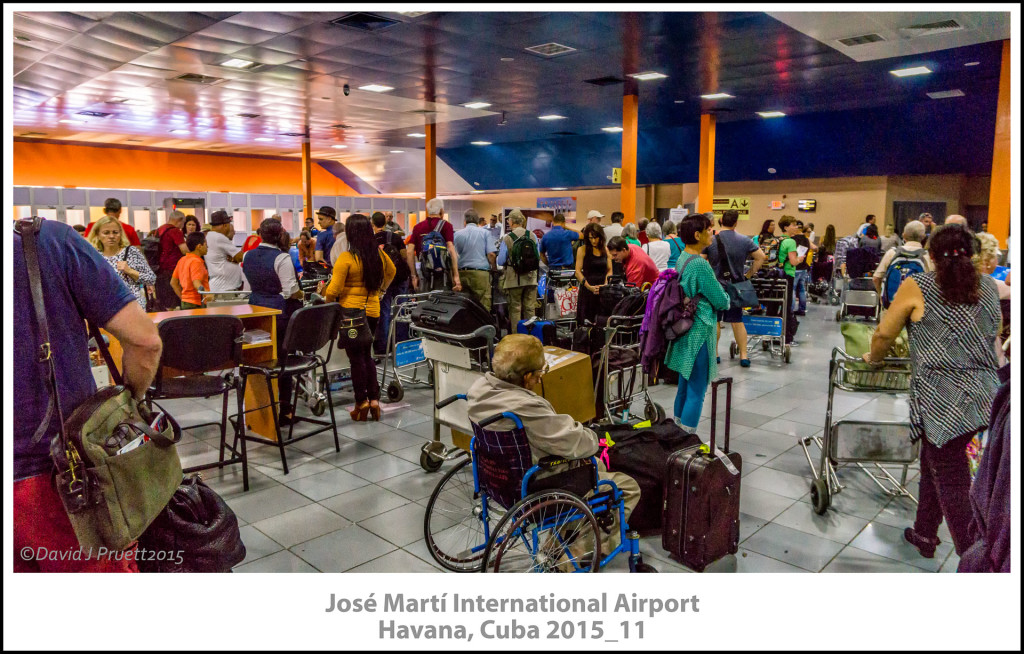
|
